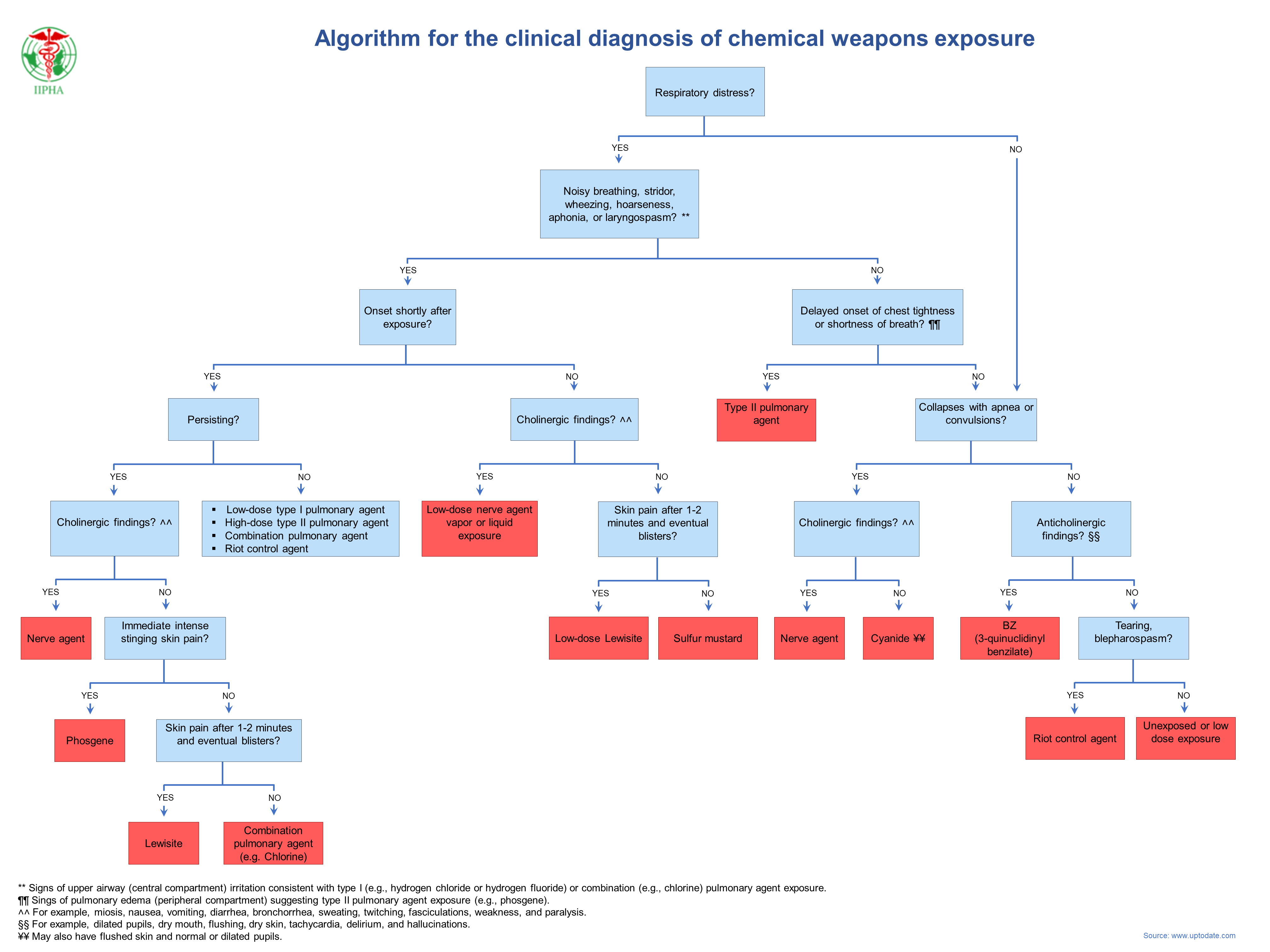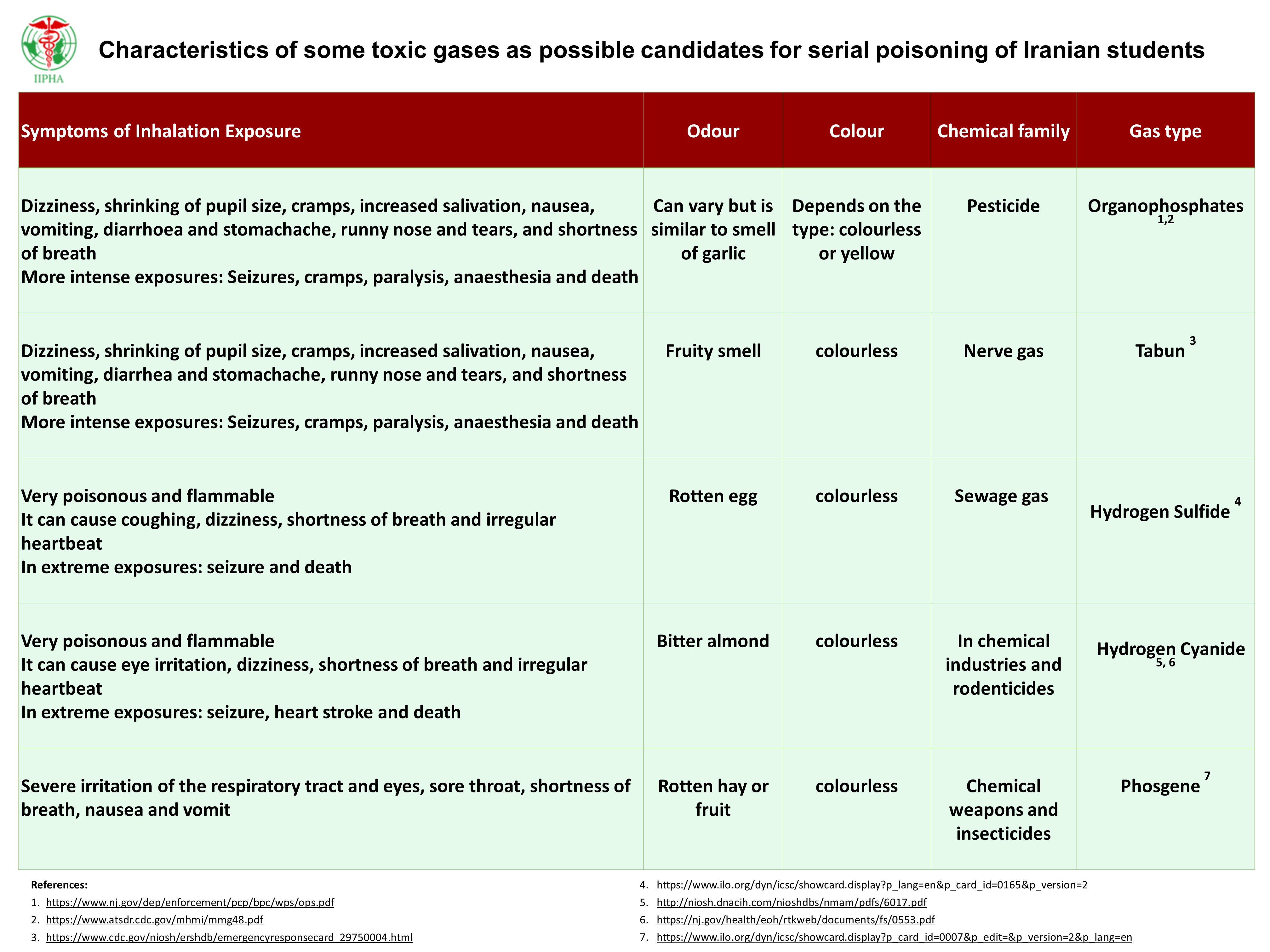In the second part of this article series, we will discuss potential toxic substances and chemical gases based on the available data and address some of the questions raised.
It is important to note that the reports by IIPHA were created to investigate the possible factors involved in the mass poisoning of schoolgirls in Iran, relying solely on evidence and reports from students and medical professionals due to the lack of direct access to victims and laboratory samples. Scientific resources were utilized to produce these reports.
The UpToDate website, a well-respected evidence-based clinical and scientific resource, provides a clinical diagnosis algorithm for exposure to chemical weapons that include clinical signs and symptoms of poisoning. This algorithm can be used as a diagnostic reference for experts.

Additionally, the available information from victims of recent serial poisonings in Iran suggests that several specific agents commonly used in the chemical industry, such as pesticides, could be potential factors. Organophosphates, tabun, hydrogen sulfide, hydrogen cyanide, and phosgene are some of the possible candidates for these poisonings.
The table below outlines the symptoms of inhaled exposure, odour, colour, chemical group, and type of gases.

In addition to discussing the cases that can aid in diagnosing and treating poisonings, this section of the article will also address questions raised by the public and authorities.
Question: Can surgical masks or filter masks like N95 and N99 reduce the damage caused by exposure to toxic agents? Could these masks protect individuals from poisoning by these gases?
Answer: No, medical and other filter masks are designed to deal only with larger particles in the air, such as dust and microbes. They cannot protect people from chemical agents, as small molecules can easily pass through the layers of these masks. When dealing with exposure to chemical and poisonous gases, a gas mask respirator specifically designed for that purpose should be used. Therefore, if the poisoning agents in Iranian schools are considered “toxic gas exposure,” masks should not be recommended as a protective method.
Question: Can exposure to naphtha be considered one of the causes of serial poisoning in Iranian schools, according to Tasnim news agency?
Answer: Petroleum naphtha is an intermediate hydrocarbon liquid stream derived from the refining of crude oil, and it is lighter than gasoline.
In an interview with Tasnim news agency on March 3rd, Reza Karimi Saleh, deputy governor of Pardis, referred to the poisoning of students as “a tanker carrying naphtha fuel in the vicinity of the school,” but is this claim true?
This assumption is not scientifically correct. Although naphtha is more volatile than gasoline, for its concentration to be poisonous even in the vicinity of the source of pollution, it must become more volatile with heat or sprayed into the air. In other words, the concentration of naphtha evaporated from the fuel tanker was insufficient to cause poisoning. Furthermore, people can smell naphtha even in acceptable concentrations in workplaces (a concentration equal to 10% of the acceptable dose for 8 hours of occupational exposure). If the poisoning of students had been caused by naphtha, many of them would have noticed its existence before it reached dangerous levels.
Moreover, naphtha vapours are about 3.85 times heavier than air, making it highly unlikely for high concentrations of naphtha mists to penetrate the school. Therefore, it can be concluded that naphtha exposure cannot be considered one of the causes of serial poisoning in Iranian schools.
Question: Can exposure to nitrogen be considered a cause of serial poisoning in Iranian students, according to the head of the Education Commission of the Islamic Consultative Assembly?
Answer: According to a report by the IRNA news agency on February 29, 2023, Alireza Monadi Sefidan, the chairman of the Education, Research and Technology Commission in the Islamic Parliament, stated that nitrogen gas was detected in the poison released in schools and was one of the causes of poisoning of students in Qom and Boroujerd, based on investigations conducted by 30 experts from the Ministry of Health.
To understand this claim, it is important to know more about nitrogen gas (N2). Nitrogen is a neutral gas and is not considered toxic. It can, however, cause suffocation and death at high concentrations. The air we breathe normally contains about 78% nitrogen gas and 21% oxygen gas, with about 1% of other gases like water vapour, argon, and carbon dioxide.
Therefore, since nitrogen is naturally present in the air we breathe, it cannot normally be considered a poisoning agent. However, if the concentration of nitrogen is much higher than usual and replaces air oxygen, it can cause symptoms of oxygen deficiency. Nitrogen at concentrations above 78% can cause us to receive less oxygen, and only “very high” concentrations can cause choking.
In closed environments where air circulation is limited, such as nitrogen reservoirs in industrial sites, nitrogen concentrations can reach dangerous levels, causing symptoms such as dizziness, increased heart rate, unconsciousness, and even death. However, there is no possibility of nitrogen poisoning in public environments such as schools, and such a scenario is invalid.
In conclusion, while nitrogen gas can cause suffocation and death at high concentrations, it is not considered a poisoning agent in the context of the recent serial poisonings in Iranian schools. The report will be updated as more information becomes available.
The information on this topic is subject to change as new evidence emerges, and the report will be updated accordingly.
آدرس ما در آمریکا
2785 PACIFIC COAST HWY. SUITE E719 TORRANCE, CA 90505 USA
به ما پیغام بفرستید
@theiipha
از ما بپرسید
info@iipha.org
به ما خبر بدهید
secure@iipha.org
